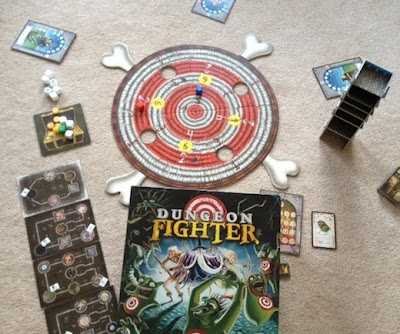Quantum set up for two players. Wine and GoT coasters not included.
I love Star Wars. I really enjoy science fiction movies, books, and TV shows. I would love to love science fiction themed games...but my main gaming partner, my lovely wife, does not care for the "space" theme at all. So it is rare that any "space games" make it into our home. With this big factor going against it, does Quantum make the "Flartner" cut?
Quantum is the latest from publisher FunForge and designer Eric Zimmerman. Quantum is a lighter space civilization and combat game where the players' ships are represented by dice. The goal of the game is for each player to construct all of her quantum cubes on empty planets.
Players construct their cubes on planets by having ships in orbit around a planet that are exactly equal to the planet's number.
On a turn a player gets 3 actions. Players can Reconfigure a ship by rerolling it, Deploy a destroyed ship to the board, Construct a Quantum Cube (which costs 2 actions), Research (which can help a player get powerful Advance Cards). The last option is to have a ship Move/Attack. A ship can move as many spaces as it has pips on its face - so a ship represented by a die showing a 5 could move 5 spaces.
In this combat example, blue's Destroyer narrowly defeats yellow's Interceptor.
Ships attack by moving into a space containing an enemy ship. Each player involved rolls one combat die and adds this to the value of the ship in combat. The player with the lower total wins. This means the game asks players to strike an interesting balance between their ships' mobility against their ships' effectiveness in combat.
All civilizations play exactly the same - aside from color and name.
...that rhyme was an accident...I promise.
...that rhyme was an accident...I promise.
There are also 6 Advance Cards available for players to take. The cards come in two varieties, gambit cards (which trigger instant effects) and command cards (which are ongoing effects). These can be acquired in any of 3 ways: by constructing a quantum cube, by destroying an enemy ship, or by getting your research die up to 6.
As with any game with cards and dice, there is a good amount of randomness included in the game. This might push some players the wrong way. The randomness of Reconfiguring a ship can be frustrating if a player gets exactly the ship they want, and some of the cards in the game do seem much stronger than others. Both of these issues are mitigated somewhat by the game's relatively short playing time and fairly abstracted rule set. Speaking of abstraction, that is another possible issue for Quantum. The game is about space ships warring and colonizing planets, but some ships can swap place with each other? And any ship can randomly change into another kind of ship? These make for exciting and interesting game play elements, but go a long way to making the game feel more abstract and themeless.
I think that Quantum overcomes these few shortcomings and is ultimately a very fun, very engaging game. I have always thought that many strong games have one thing in common - a small number of simple rules but a great number of interesting decisions. Quantum is a prime example of this type of game. The rules are fairly limited, but the way the rules come together and interact with each other create a fairly deep play space which is quite fun for players to explore. The most basic concept of the game - that the stronger a ship is, the slower it is, and vice versa - is a perfect distillation of this idea. Quantum seems to take many things that make space games fun, and reintroduces them with the old K.I.S.S. principle, very much to it's benefit.
Overall, I would give Quantum a 7.0/10. It is a very fun little space game that would fit well in many a collection. There will be frustrating randomness at times, and there is definitely some theme wonkiness, but these are both reduced as negative factors by the game's shorter length and relatively broad strategic play space. This may not be the next Eclipse, but it was never trying to be. Quantum is one of those creative endeavors that doesn't overreach, but absolutely nails what it was going for - quick gameplay, simple but difficult decisions, all wrapped up in a pretty space package. I recommend you check it out.


